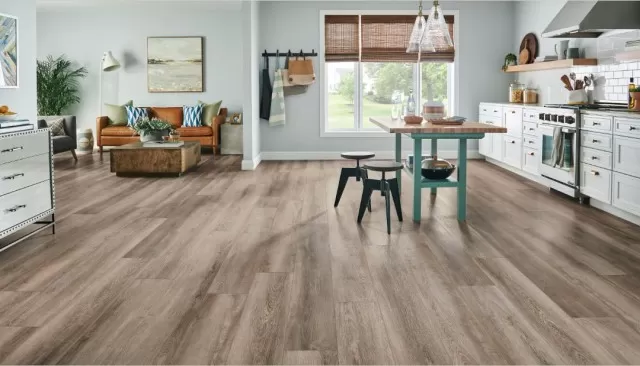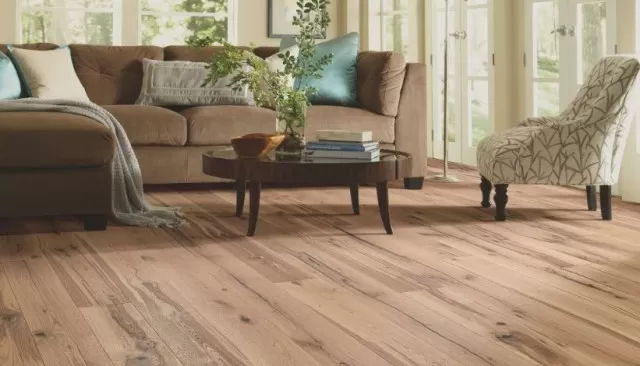When accidents happen and spills occur on wood floors, a quick wipe with a cleaning solution is typically sufficient to clean up the mess.
However, if spills are left unattended, they can result in lasting stains.
For example, a full glass left on the floor overnight or an inadequately cleaned spill can leave unsightly and distracting stains on your beautiful hardwood floors. But before you panic about a blemish, it’s important to know that there are potential options for removing stains from wood floors.
The effectiveness of stain removal will depend on the type and depth of the stain.
By following these steps and tips, you can learn how to remove stains from wood floors, including watermarks, and understand which stain removers to use. With proper treatment, your hardwood floor can regain its pristine appearance as if the stain never occurred.
To successfully remove wood floor stains, it’s essential to first examine the appearance of the ring or watermark.
The way the stain looks provides important clues on how to address it effectively. For instance, white stains usually indicate surface-level water stains that are relatively easy to remove.
Conversely, dark brown or black stains suggest deeper, more challenging stains that may require additional effort. The color of the stain helps determine whether it is confined to the floor’s waxy surface layer or if it has penetrated the finish and reached the grain of the wood.
How to Remove White Rings and Watermarks from Wood Floors

If you notice white water rings on your wood floor, there are several methods you can try to remove them.
First, allow the stain to dry for a couple of days to see if it disappears naturally. If not, consider the following techniques for removing white water rings:
- Clean Waxed Floors: If your floor has a wax or penetrating stain finish, gently rub the water stain with extra fine grade #000 steel wool and wax.
- Lightly Sand Stain (If Needed): If the above method doesn’t work, lightly sand the stained area with fine sandpaper.
Clean the sanded area using fine grade #00 steel wool and mineral spirits or a wood floor cleaner. Allow the floor to dry, then stain, wax, and buff the area by hand.
- Clean Urethane-Finished Floors: For floors with a surface finish, use a cleaner specifically designed for urethane finishes.
Scrub tricky spots using a cleaner and a scrub pad suitable for urethane floors.
- Remove Stubborn Stains: If the above methods don’t succeed, you can try covering the stain with a dry cotton cloth and rubbing a hot iron (not set on steam) over it for a few seconds.
Another option is to dampen a cloth with denatured alcohol and iron over the stain briefly.
How to Remove Dark Water Stains from Wood Floors

Dark water stains or black rings can be more challenging to remove as they have likely penetrated the finish of the wood.
You have two options for removing these stains:
- Use Bleach and a Toothbrush: Dip a small brush, such as a toothbrush, into a small amount of bleach and rub it onto the stain.
Repeat this process after several hours and let the area rest overnight.
- Strip, Sand, and Reseal: Alternatively, you can strip the affected area, sand it, and reseal it to remove the dark water stain.
How to Get Other Stains Out of Wood Floors

For stains caused by non-greasy items like food or nail polish, follow these steps:
- Rub with Cleaning Product: For greasy stains or floors with wax or penetrating finishes, rub the area with a kitchen soap that has a high lye content.
Alternatively, soak a cotton ball or rag with hydrogen peroxide and place it over the stain.
- Add Ammonia: Saturate another piece of cotton with ammonia and layer it on top of the cotton soaked in hydrogen peroxide.
Repeat this process until the stain is gone.
- Dry and Buff: Allow the spot to dry, then buff it by hand.
Treat greasy stains on surface-finished floors using the same steps.
When to Call a Professional:
It’s important to follow general guidelines for cleaning wood floors, using minimal moisture, and ensuring thorough drying.
Use products recommended for your specific type of flooring and finish. If you’re dealing with a stubborn or large stain, consider contacting a flooring professional who can provide advice on stain removal methods that won’t cause irreversible damage.
*The information is for reference only.